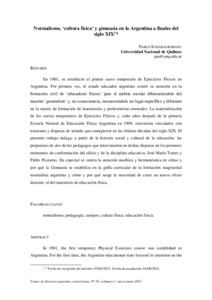Por favor, use este identificador para citar o enlazar este ítem:
https://repositorio.uca.edu.ar/handle/123456789/11994| Título: | Normalismo, ‘cultura física’ y gimnasia en la Argentina a finales del siglo XIX | Autor: | Scharagrodsky, Pablo | Palabras clave: | PEDAGOGIA; CUERPO; EDUCACION FISICA; EJERCICIO FISICO; EDUCACION | Fecha de publicación: | 2021 | Editorial: | Pontificia Universidad Católica Argentina. Facultad de Ciencias Sociales. Instituto de Historia Argentina y Americana | Cita: | Scharagrodsky, P. Normalismo, ‘cultura física’ y gimnasia en la Argentina a finales del siglo XIX [en línea]. Temas de Historia Argentina. 2021, 29 (1). Disponible en: https://repositorio.uca.edu.ar/handle/123456789/11994 | Resumen: | Resumen: En 1901, se estableció el primer curso temporario de Ejercicios Físicos en Argentina. Por primera vez, el estado educador argentino centró su atención en la formación civil de ‘educadores físicos’ para el ámbito escolar diferenciándolo del maestro ‘generalista’ y, en consecuencia, reconociéndole un lugar específico y diferente en la matriz de formación de maestros/as y profesores/as normales. La materialización de los cursos temporarios de Ejercicios Físicos y, ocho años después de la primera Escuela Normal de Educación Física Argentina en 1909, estuvieron vinculados con tensiones y disputas de sentido que emergieron en las últimas décadas del siglo XIX. El presente trabajo indaga, a partir de la historia social y cultural de la educación, las propuestas de dos de los pedagogos que intervinieron en dichas disputas en los primeros momentos de conformación del oficio y de la disciplina educativa: José María Torres y Pablo Pizzurno. En especial se centra la atención analítica y hermenéutica en cómo y por qué la Gimnasia se estabiliza en la grilla curricular de la formación magisterial normalista argentina y cómo y por qué surge la necesidad de crear un nuevo oficio docente: el del maestro/a de educación física. Abstract: In 1901, the first temporary Physical Exercises course was established in Argentina. For the first time, the Argentine educational state focused its attention on the 'physical educators' civil training for the school environment, differentiating it from the 'generalist' teacher and, consequently, recognizing a specific and different place in the teacher and normal teachers training matrix. The materialization of the temporary courses of Physical Exercises and, eight years after the first Normal School of Argentine Physical Education in 1909, was linked to tensions and disputes of meaning that emerged in the last decades of the 19th century. Based on the social and cultural history of education, the present work investigates the proposals of two pedagogues who intervened in these disputes in the first moments of the trade and the educational discipline formation: José María Torres and Pablo Pizzurno. In particular, analytical and hermeneutical attention is focused on how and why Gymnastics stabilizes in the curricular grid of Argentine normalist teacher training and how and why the need arises to create a new teaching profession: the physical education teacher. |
Cobertura Espacial: | Argentina | Cobertura Temporal: | SIGLO XIX SIGLO XX |
URI: | https://repositorio.uca.edu.ar/handle/123456789/11994 | ISSN: | 1666-8146 (impreso) 2618-1924 (online) |
Disciplina: | HISTORIA | Derechos: | Acceso abierto | Fuente: | Temas de Historia Argentina y Americana. 2021, 29 (1) |
| Aparece en las colecciones: | TEM - 2021 nro. 29 vol 1 |
Ficheros en este ítem:
| Fichero | Descripción | Tamaño | Formato | |
|---|---|---|---|---|
| normalismo-cultura-fisica-gimnasia.pdf | 385,41 kB | Adobe PDF |  Visualizar/Abrir |
Visualizaciones de página(s)
345
comprobado en 30-abr-2024
Descarga(s)
368
comprobado en 30-abr-2024
Google ScholarTM
Ver en Google Scholar
Este ítem está sujeto a una Licencia Creative Commons

